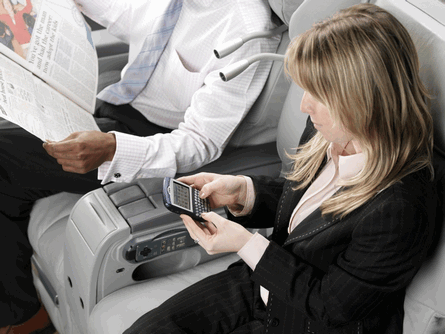Airlines of every size and status, from the staunchly low-cost to the fervently high-end, are no longer taking a wait-and-see approach to connectivity, as systems developed by AeroMobile, Aircell and OnAir prove successful, and others from Row 44 and Panasonic Avionics show promise.
“Connectivity is the buzz word of the show. It is finally coming to reality," said Panasonic Avionics director of corporate sales and product Neil James during the World Airline Entertainment Association’s conference and exhibition last week in Long Beach, California.
During the event, in-flight cellphone system operator AeroMobile announced that it is in advanced talks with four more carriers, which would add to its existing customer base comprising Emirates, Qantas, Saudi Arabian Airlines, Turkish Airlines and V Australia.
 |
|---|
In addition, rival OnAir secured its first contract in Latin America through a deal with Brazilian carrier TAM to introduce mobile connectivity in mid-2009. Chinese carrier Shenzhen Airlines is bypassing trials of the system completely and should start offering its passengers the service before the end of the year after its original target slipped. And Irish budget carrier Ryanair is expected to start testing OnAir within the next couple of weeks once final regulatory approvals are in place.
Boasting perhaps one of the biggest announcements, however, was Aircell, which revealed that Air Canada has become its fourth customer, agreeing to ultimately equip its entire domestic fleet with the Colorado-based firm's WiFi offering.
By spring 2009 the Star Alliance member airline will begin offering Aircell's Gogo service aboard Airbus A319 aircraft on select transborder flights to the US west coast. Gogo is supported by Aircell's existing air-to-ground (ATG) network and only available in the USA. The service will become available to Air Canada passengers once the aircraft reaches US airspace.
However, Aircell is working on the licensing and rollout of a Canadian air-to-ground network, which will make Gogo available in Canada and facilitate Air Canada's future fleet-wide deployment. Talks between Transport Canada, Industry Canada and the airline have been fruitful, reveals Air Canada senior director of product design Louise McKenven. "Nobody has an air-to-ground [licence] in Canada. They need an interested party. I don't know who the Canadian government will license it to," says McKenven.
Air Canada is also keen to work with Aircell to offer connectivity on overseas flights. This will require Aircell to either develop its own satellite-based solution or partner with another such provider. "We've tested some antennas in Europe. It's still not a clear picture when technology will be the right size, the right weight and offer the right accuracy for pinpointing to satellites," says Aircell senior vice-president airline solutions Fran Phillips.
Like Canada, Mexico has a spectrum set aside for ATG. "We need to work with a partner and build out a network there too," says Phillips.
Even with clear challenges ahead, the in-flight entertainment and communications industry is certain that some of the biggest hurdles to entry - scepticism about reliability and passenger take-up - is quickly diminishing.
"The AeroMobile service has been used by many thousands of customers around the world since it launched with Emirates in March and, as we and Emirates fully expected, there has not been a single negative incident surrounding it," says AeroMobile chief executive Bjorn-Taale Sandberg. "On the contrary, it has been warmly welcomed by passengers."
Source: Flight International
















